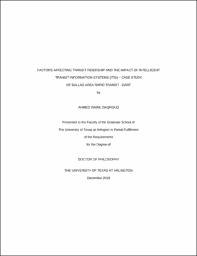| dc.description.abstract | Transit ridership is at the heart of transportation policy making and the success of any transit system. Urban planners have been focusing on the need to reduce car dependence and promote more sustainable transportation alternatives. Automobile dependence is a concern for many reasons including congestion in urban areas, pollution, and environmental damages. Switching to more sustainable and environmentally friendly transportation modes such as public transit is likely to be an effective solution to most of these problems. As an alternative to the private car, public transit is an effective means to move large numbers of people within cities, and transit systems play an important role in combating traffic congestion, reducing carbon emissions, and promoting compact, sustainable urban communities (Taylor et al., 2009). In recent years, the introduction of intelligent transit information systems (ITIS) applications that provide real time information to transit users created a new hope for increased transit ridership, however, its impact in facilitating increased Transit Usage is not clear yet.This study explores the factors affecting transit ridership including ITIS and selects the Dallas Area Rapid Transit (DART) as a case in a large metropolitan setting for this research. In order to achieve this purpose, the research examines the factors affecting rail, bus, and transit ridership. In addition, this research attempts to fill some of the gaps that exist in the literature by exploring the impact of intelligent transit information systems (ITIS) on transit ridership, and how its availability has affected transit ridership since 2012. The study adopts a monthly time series perspective (2007 to 2017) to enable the researcher to examine changes in transit ridership over a 10 year period and the incremental exposure to ITIS technology. This enables the research to capture any changes in ridership over this 10 year period, few years before to few years after the implementation of ITIS transit applications, in addition to any seasonal changes. Most previous studies of transit ridership have not included ITIS as one of the variables thought to influence transit ridership. Therefore, the disparities among the findings of empirical research completed to date point out to the necessity for further study. This study addresses these shortcomings by exploring multiple factors measuring population, technology, geography, and socioeconomic characteristics. This is examined through using Time Series / Multiple Regression methods on the dataset to estimate the relationship between the models' variables to answer the research questions related to demand for transit ridership in the DFW area. In this type of research quite frequently, one is interested in interpreting the effect of a percent change of an independent variable on the dependent variable, which we can achieve through a double-log (log-log) model. As such, the elasticity of demand for transit with respect to some of the factors in the model such as percent change in fare, income or the research question variable, ITIS usage, are explored and policy implications out of these elasticities are discussed. Finally, it has been argued that ITIS reduces negative aspects and cost of using transit through providing information, saving time and other attributes, and makes transit more competitive with the automobile. Therefore, it behooves us to include also some measure of auto ridership in the models. In order to measure the responsiveness of demand for transit to a relative change in the price related to auto usage, we examine cross-price elasticity of demand for transit and how cross-price elasticity of demand could help us in measuring possible shifts from car to transit as an effect of ITIS usage. We think this research provides a significant contribution to transportation planning literature. | |


